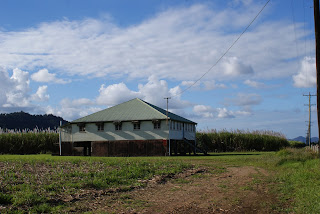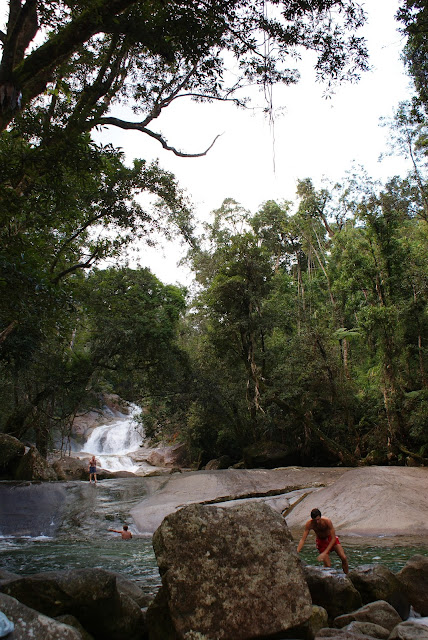On the way north from Townsville to Cairns we stopped at a
beautiful little national park set back into the hills behind the sugar cane fields- Josephine Falls. While the water looked too cold for us
there were plenty of hardy, albeit younger, people taking their chances. (There
were plenty of warning signs, stating that people had been killed or seriously
injured as the river can rise at any time, the stream is cold and rocks
slippery! Flash flood are common!) The walk in through lush tropic rainforest
was delightful and Amelia thoroughly enjoyed stretching her legs and running
ahead on the excellent paths.
Typical "Queenslander" house, with plenty of height for air circulation
A few brave souls testing the water!
“Our people ate nuts,
fruit, tubers, fish, scrub turkeys, eggs, possums and carpet snakes. They
buried nuts underground at camps when there were plenty around and dug them up
when they were out of season.”
“Our people knew what
time of year to eat wildlife, when they were fat enough to eat and not
breeding. Everything was centred around the seasons. In the time of the jigaru
(thunderstorms), moongarra (Australian bush turkeys/ scrub turkeys) began
nesting and everybody looked forward to
a change of diet to bumboo (turkey eggs). When certain trees flowered it was
time to catch fish, Our people knew about food by reading the seasons”
“When the men went
hunting, they always asked permission of the animal spirits first before
killing animals for food. They only took what they needed. All families had
animal totems they wouldn’t hunt. Our old people never killed animals in their
breeding season and never killed female animals”
It rains here about 250 days a year resulting in between 5-8
metres annually and at times 12 metres on the summit. This was evident on the day
we arrived as the cloud obscured our view of the summit and it was much cooler
than Townville or Cairns.
Mount Bartle Frere was named in 1873, after the then
president of the Geographical Society in London. Shortly after Palmerston (explorer
and prospector) and his associates discovered gold on the upper Russell river
and its tributaries, prompting a short gold rush. (The gold has hard to find
and conditions harsh). Many miners left after a short time, few with decent
findings. From the turn of the 20th century, industry took over,
with mining, agriculture, farming and timber harvesting dominating traditional
lands. The early settlers thought of the land as hostile jungle and wanted to “put
it to good use”. Many of the traditional owners moved in the western parts of
their lands, while some gained employment as miners, farmers or timber workers,
while the women went into domestic services. Attitudes slowly changed and in
1921, parts of the Bellender Ker Range, including Mt Bartle Frere were declared
national park.










No comments:
Post a Comment